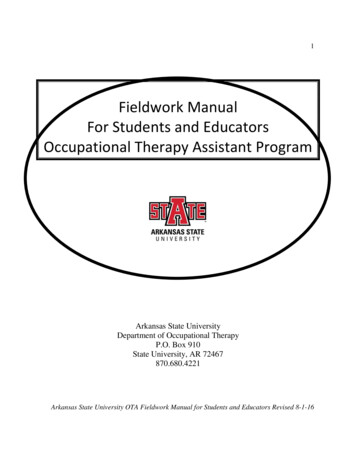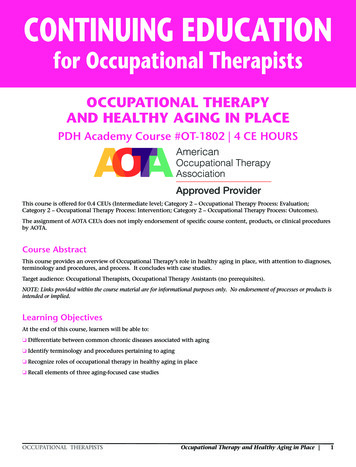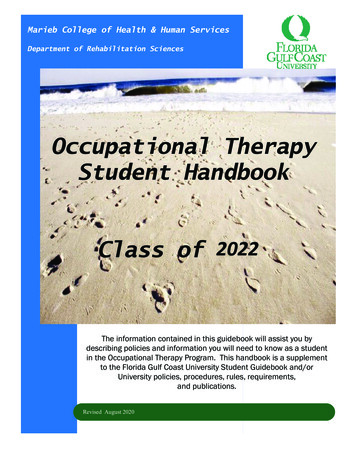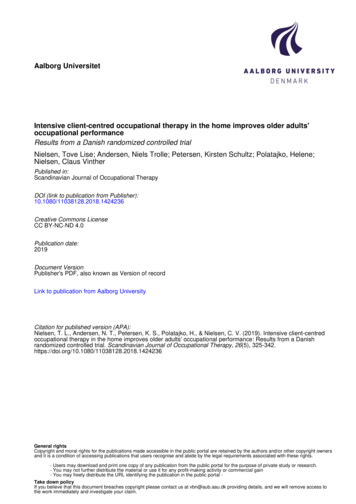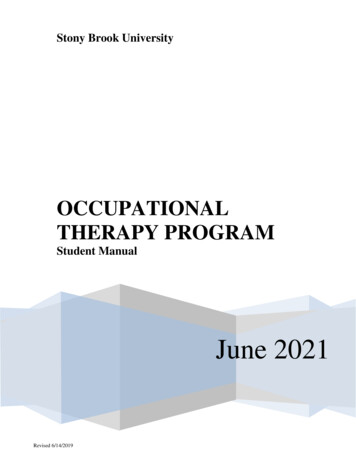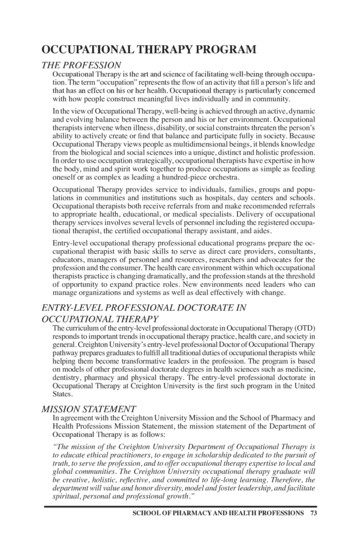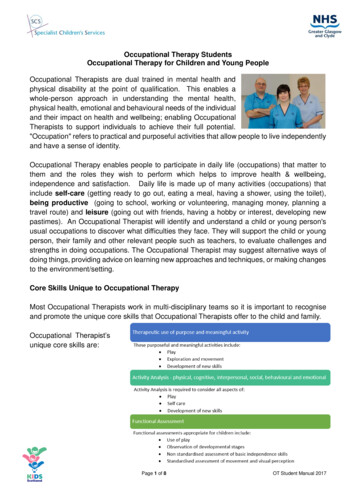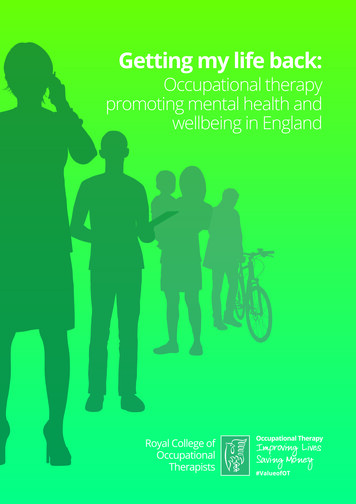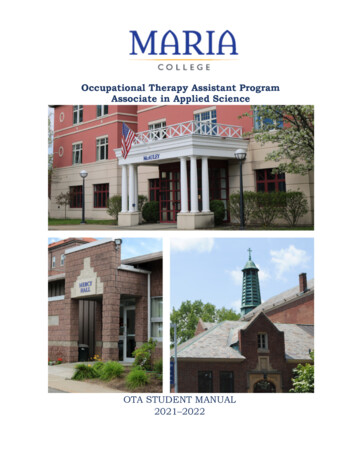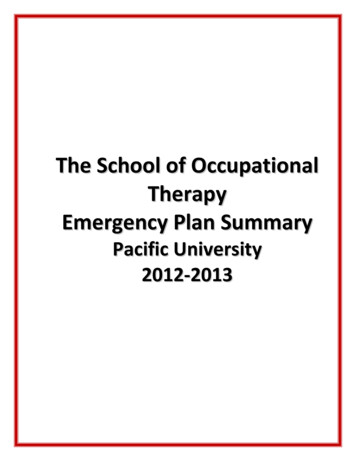
Transcription
The School of OccupationalTherapyEmergency Plan SummaryPacific University2012‐2013
TABLE OF CONTENTSPURPOSE & SCOPE . 2EMERGENCY ADMINISTRATION SYSTEM (EAS) . 2BUILDING SAFETY MANAGERS . 2EVACUATION PROCEDURES. 2ADDRESS BUILDING NAME . 3DESIGNATED ASSEMBLY AREAS. 3GENERAL EMERGENCY PROCEDURE . 3REPORTING SAFETY HAZARDS . 4SPECIFIC SCENARIO EMERGENCY PROCEDURES . 4Accident/Injury/Medical Emergency . 4Fire . 5Earthquake . 6Flood . 6Weather Storm . 7Chemical Spills and Releases . 9National/Regional Emergency . 9Pandemic Influenza . 10Protest Activity, Marches & Demonstrations . 10Active Shooter . 11Armed Intruder . 11Bio‐Terrorism . 13Exposure Control Procedure . 14Bombs . 15Telephone Bomb Threats. 17RESOURCES . 18Page 1 of 19Edited for OT 4/2/13Building Safety/Emergency PlanUniversity Revision 1/2011
EMERGENCY PLAN SUMMARYSTUDENT INFORMATIONPURPOSE AND SCOPEThe Pacific University Emergency Plan is intended to serve as a guidance document in the event ofan emergency. The student handbook has been created from the master Emergency OperationsPlan, including topics and content that are applicable to students in the School of OccupationalTherapy, College of Health Professions, Pacific University. The purpose of the guidelines is tominimize a threat to life, health, and property due to scenarios such as natural disasters, medicalemergencies, and fires. It is important for students to be familiar with the Emergency Plan beforean emergency is “at‐hand”. This is to be accomplished through distribution of the Emergency Planhandbook and the orientation process provided to incoming students.EMERGENCY ADMINISTRATION SYSTEM (EAS)Pacific’s emergency administration system follows a prioritized, systematic and organized routine.An Emergency Operations Center (EOC) has been established on main campus in Forest Grove.BUILDING SAFETY MANAGERSThe Building Safety Manager Program was created by the Pacific University Health & SafetyAdvisory Committee and authorized by the University President. The program is included in the“Health & Safety Advisory Committee: Policy/Procedures Statement”. As part of the program,each building or area of Pacific University has an assigned Building Safety Manager (BSM).In each building, the “Safety Bulletin Board” contains a current list of the BSMs and their phonenumbers. Each member of the campus community should familiarize themselves with thelocation and contents of the “Safety Bulletin Board”. Although Campus Public Safety is the mainresource for on‐campus emergencies, the Building Safety Manager is an important “contact point‐person” for obtaining information about a situation in a given area.Building Safety Manager, School of Occupational TherapySuzie Brandes, 503‐352‐7344.Campus Public Safety, College of Health ProfessionsHPC 2, Ground Level503‐352‐7207EVACUATION PROCEDURES:Page 2 of 19Edited for OT 4/2/13Building Safety/Emergency PlanUniversity Revision 1/2011
The Building Safety Monitors will check all rooms on their floors, and alert students of theemergency, if they do not already know. It is important for everyone to exit the building asquickly and safely as possible. DO NOT USE THE ELEVATORS. If you are disabled and needassistance evacuating, notify a fellow building occupant or move to the established Area of RescueAssistance (ARA) or the nearest stairwell.ADDRESS BUILDING NAME222 SE 8TH Ave., Hillsboro, OR – Creighton Hall190 SE 8th Ave., Hillsboro, OR ‐ HPC ‐2ASSEMBLY AREA:All occupants should proceed to their Designated Meeting Site in the flat Parking Lot at 8th Ave &Washington St. and await further instructions from their Building Safety MonitorStudents should know where primary and alternate exits are located and be familiar with thevarious evacuation routes available. The doors to the front stairwells will close on detectingheat/smoke, however they can still be easily pushed open to allow emergency egress.DO NOT LEAVE FROM THE ASSEMBLY AREA UNTIL YOU HAVE BEEN GIVEN THE “ALL CLEAR” BYAUTHORIZED PERSONNEL TO RETURN TO THE BUILDING.It is crucial that everyone can be accounted for should the incident require search and rescueoperations.GENERAL EMERGENCY PROCEDURESCampus Public Safety (x7207) is the only department on campus that is staffed 24 hours per day, 7days per week, and 365 days a year. They are the key contact for all campus emergencies.The GENERAL emergency procedure is as follows:Non‐“911” Campus emergencies(minor injury, First Aid, vehicle accident on campus, unwanted actions, etc.)1. l. Call campus public safety (x7207)“911” Campus emergencies(there is a clear need for immediate outside police, fire or medical assistance):1. Call 9112. Clearly state the type of emergency to the dispatcher (i.e. police, fire, medical)3. Clearly state the location of the emergency and your name, location, and telephone number. Allphones throughout the school have been labeled with the physical addresses of both buildings.4. Describe the emergency5. Do not hang up until told to do soPage 3 of 19Edited for OT 4/2/13Building Safety/Emergency PlanUniversity Revision 1/2011
6. Call Campus Public Safety (x7207); notify them 911 has been called and emergency personnel areen routeREPORTING SAFETY HAZARDSAny safety issue should be reported to Campus Public Safety (x7207), or if minor, to the OTadministrative office (x7268).o Campus Public Safety will contact other personnel as requiredCampus Public Safety 24 hours a day: 503‐352‐7207 Always notify the Police Department by calling 911 as soon as it is safe to do so. Emergency notification of an active shooter on campus will consist of the following alerts:o Carillon system‐Emergency PA system.o Air horns – there are air horns located in each building. The air horns will sound 5 blaststo designate an active shooter on campus.Boxer alerts – This consists of students who have signed up receiving text message withan emergency alert and also all faculty/staff/students will receive an emergency emailmessage.SPECIFIC SCENARIO EMERGENCY PROCEDURESAccident/Injury/Medical Emergency:IN THE EVENT OF AN ACCIDENT/INJURY/MEDICAL EMERGENCY:1. Ensure the safety and health of the person injured.2. Notify Campus Public Safety as soon as possible 503‐352‐7207.3. If immediate medical, fire or police assistance is needed, Call 911 (Contact CPS 503‐352‐7207following)4. **Check the Material Safety Data Sheet (MSDS) if chemicals or other toxins are involved.a) The MSDS's are on file in the OT Administrative office.5. Notify the Program Director, or Administrative Staff.If Outside Medical Assistance is required (or if you think it might be):1. Do not move an injured person unless it is a life‐threatening situation.2. Call 9‐1‐13. Clearly state to the dispatcher that you are reporting a medical emergency and give yourname, location and telephone number.4. Describe the medical emergency.5. Do not hang up until told to do so.6. Call Campus Public Safety (x7207) and notify them that 9‐1‐1 has been called andemergency personnel are on the way.7. Stay with the injured person and try to keep him/her calm until outside medical personnel orCampus Public Safety arrive.Student Injury ProtocolPage 4 of 19Edited for OT 4/2/13Building Safety/Emergency PlanUniversity Revision 1/2011
1. In a medical emergency, call 911. Do not move the injured student unless more harm will beincurred by keeping them stationary (e.g. risk of fire/burns/falling debris/etc.).2. Stay with the injured person(s) and provide basic first aid within your scope of training asindicated by the situation.3. If uncertain as to whether injury is an emergency, you may call 911 for assessment andpossible transport.4. Notify Campus Public Safety (x2230) if 911 has been called and emergency personnel are enroute.5. If the injury is not severe but medical attention is needed, proceed to an urgent care oremergency room. You may also contact the Student Health Center @ 503‐352‐2269 forassistance with triage questions and availability of services. Locations of local facilitiesinclude: Tuality Forest Grove Hospital1809 Maple St, Forest Grove – phone: 503‐359‐6180 Tuality Hillsboro Hospital335 SE 8th Ave, Hillsboro‐phone: 503‐681‐1860 Tuality Urgent Care7545 TV Hwy, Hillsboro – phone: 503‐681‐42236. Once the situation has fully stabilized, the student should fill out a Student Accident/IncidentAnalysis form which is available online at www.pacificu.edu/healthcenter under StudentInjury Protocol and at the Student Health Center. The completed form should be returned tothe Student Health Center, attn. Clinic Director‐UC box 673.7. Student Accident/Incident Analysis forms are reported (with the student name omitted forconfidentiality) to the Health and Safety Advisory Committee for review and discussion ofprevention and corrective action planning with regards to campus safety issues.8. Any medical expenses incurred as a result of the injury should be billed to the student’spersonal insurance carrier.Fire:Be sure you know the location of fire extinguishers, exits, and pull stations in your area. If abuilding fire alarm sounds (or if told to do so by Campus Public Safety or other emergencypersonnel) evacuate the building immediately. Do not bet your life on an alarm being a falseone.If you discover a fire and/or smoke:1. Isolate the fire by closing all doors on your way out; do not lock the doors2. Do not attempt to fight a fire alone; only attempt extinguishing a fire if it is a minorone that can quickly and easily be put out with a portable fire extinguisher and only ifyou are trained in the use of such an extinguisher.3. Report the fire and/or smoke by activating the nearest fire alarm, Call 9114. Evacuate to a designated assembly areaa. Do not use elevators when evacuating – use the stairs!b. Do not stop for personal belongings or recordsPage 5 of 19Edited for OT 4/2/13Building Safety/Emergency PlanUniversity Revision 1/2011
c. Do not stand in smoke (the greatest danger during a fire!); instead, drop to your kneesand crawl to the nearest exit; cover your mouth with a cloth, if possible, to avoidinhaling smoked. Assist disabled persons5. If you become trapped:a. If a window is available, open it and place an article of clothing (shirt, coat, etc.)outside the window as a marker for emergency personnelb. Stay near the floor where there is the least smokec. Cover your mouth with clothing to avoid inhaling smoked. Do not open a door if smoke is pouring in around the bottom or if it feels hote. Shout to alert emergency personnel of your location6. Call 9117. Clearly tell the dispatcher you are reporting a fire and give your name, location of thefire (building, floor, room number), and your telephone number8. Do not hang up until told to do so9. Call Campus Public Safety (x7207); notify them 911 has been called and emergencypersonnel are en route10. Notify both the responding fire department and Campus Public Safety personnel onthe scene if you suspect someone may be trapped inside the buildingEarthquakes:Earthquakes can strike suddenly, violently, and without warning. Although the likelihood of alarge quake occurring in the Forest Grove area is not high, the possibility exists. It is thereforeimportant for students, faculty and staff to know where they are the safest during an earthquake.If you are indoors:1. Take cover next to a heavy piece of furniture (such as a heavy desk or table) or against aninside wall and hold on, do not get under the furniture you could be crushed. There havebeen lives saved in the "triangle of life" next to furniture2. Avoid areas where glass could shatter (e.g. around windows, mirrors, pictures), or whereheavy bookcases or other furniture could fall on you3. Stay inside‐ The most dangerous thing to do during the shaking of an earthquake is to try toleave the building ‐ objects can fall on youIf you are outdoors:1. Move into the open ‐ away from buildings, street lights, and utility wires that could fall2. Once in the open, stay there until the shaking stopsAfter the quake:1. Remain calm and evacuate the building or area in an orderly manner.2. Meet in the pre‐arranged emergency gathering area for the School of OT, which is directlyacross from Creighton Hall in the open parking area, north of the MAX tracks and West ofCreighton Hall.Expect aftershocks. Although aftershocks can be smaller than the initial quake, they can causeadditional damage and bring down weakened structures. Aftershocks can occur in the firstPage 6 of 19Edited for OT 4/2/13Building Safety/Emergency PlanUniversity Revision 1/2011
hours, days, weeks, or even months after the initial quake.Flood:In the event of flooding of the Pacific University campus, or portions thereof, follow theseguidelines:If you are indoors:1. If necessary (and possible), evacuate the room or area immediately to a designatedassemblyarea (provided it is un‐affected by the flooding)2. Call Campus Public Safety (x7207)Campus Public Safety will contact Facilities Management (x2213) and/or an appropriateFacilities Engineering employee(s) if the flood is within the scope of Pacific University’scapabilities. Power will be shut off to a flooded area that poses an immediate safetythreat If the flood is beyond the scope of Pacific University’s capabilities and poses animmediate safety threat, the Forest Grove Fire Department (911) will be contacted.Power will be shut off to a flooded area that poses an immediate safety threat.3. In a flooded area, do not touch any electrical equipment while power is still onIf you are outdoors:1. Move to high ground and stay there2. Avoid walking through floodwaters; if it is moving swiftly, even water 6 inches deep cansweep you off your feetWeather Storm:Weather conditions likely to be encountered in Forest Grove and pose a safety threat includeelectrical storms and cold‐weather storms.The human body is 70% water, which makes it an excellent conductor of electricity. Lightningalways seeks out the tallest object in a given area and if that object is you, you could be burned,shocked, or electrocuted.1. Stay indoors2. If you are outside, seek shelter in the nearest building3. If you are unable to get inside a building: stay low to the ground, don’t stand under a tree(trees attract lightning which can cause them to split, fall, explode, or shock you), andstay away from fences or other metal objects than can conduct electricity4. If downed power lines are present, assume they are live and do not touch or try to movethem; if a power line falls across a car that you are in, stay in the car – if you MUSTleave it, jump clear so that no part of your body is touching the car when your feet touchthe groundCold‐weather storms can result in slip hazards on campus walkways, dangerous drivingconditions, and overhead limb or electric line hazards.1. Use extra caution when walking on campus walkways; use available handrails whenascending or descending stepsPage 7 of 19Edited for OT 4/2/13Building Safety/Emergency PlanUniversity Revision 1/2011
2. Do not stand under overhead objects, such as tree limbs or electric lines, that are heavilyweighted with snow or ice3. If downed power lines are present, assume they are live and do not touch or try to movethem; if a power line falls across a car that you are in, stay in the car – if you MUSTleave it, jump clear so that no part of your body is touching the car when your feet touchthe ground4. Employ winter driving techniques; use traction devices on university vehicles asrecommended in the Driver Training Course (coordinated by Facilities Management andthe Health & Safety Manager)Pacific University will make every attempt to keep offices and services operating in inclementweather. However, there are occasions when severe inclement weather may necessitate closureof the university. In that event, the following procedures will be observed:1. The President or designee shall make the final decision based on information provided byPublic Affairs and Campus Public Safety.2. The Director of Public Affairs, in consultation with the Director of FacilitiesManagement or others, will notify the President as soon as possible of hazardous weatherconditions, utilizing campus reports as well as local road and state highway conditionsfrom the Oregon State Police and the Washington County Sheriff’s Office.3. With this information the President will decide whether the University, with itsassociated colleges, schools and programs, shall be closed or be opened late.Portland AreaTV Stations: KATU 2 (ABC), KGW 8 (NBC), KOIN 6 (CBS), KPTV 12 (Fox)Radio Stations: KFXX AM 1080, KXL AM 750, KEX AM 1190, KKCW FM 103.3, KINKFM 102, KUPL FM 98.7, KWJJ FM 99.5, KPOJ AM 620, KKRZ FM 100,KPAM AM 860, KUIK AM 1360Eugene AreaTV Stations: KEZI 9 (ABC), KMTR 16 (NBC), KVAL 13 (CBS), KLSR 5 (Fox)Radio Stations: KMGE FM 94.5, KLCC FM 89.7, KPNW AM 1120, KUGN AM 590External resources that may be useful for incidents falling within the scope of theEmergency Plan include:On‐Campus Off‐CampusAmerican Red Cross 9.503.284.1234 503.284.1234Bomb Squad (Oregon State Police) – initial call 911 911Center for Disease ControlEmergency Response 9.1.770.488.7100 1.770.488.7100Forest Grove Fire Department (emergency #) 911 911Forest Grove Fire Department (non‐emergency #) 9.503.992.3240 503.992.3240Forest Grove Light & Power (main #) 9.503.992.3249 503.992.3249Forest Grove Light & Power (power outages) 9.503.992.3250 503.992.3250Forest Grove Light & Power(power outages after 5:00pm) 9.503.412.2444 503.412.2444Forest Grove Police Department (emergency #) 911 911Page 8 of 19Edited for OT 4/2/13Building Safety/Emergency PlanUniversity Revision 1/2011
Forest Grove Police Department(non‐emergency #) 9.503.629.0111 503.629.0111Forest Grove Public Works(sewer, street, water, maintenance) 9.503.992.3258 503.992.3258Hazardous Materials Emergency Response Team(Office of State Fire Marshal) – initial call 911 911Mental Health Crisis Line (24 hours/day) 9.503.291.9111 503.291.9111Northwest Natural Gas (emergency #) 9.1.800.882.3377 1.800.882.3377Poison Control 9.1.800.452.7165 1.800.452.7165Weather information (National Weather Service, State of OR; includes warnings & watches)Chemical Spills and Releases:If the substance presents a clear, immediate danger to building occupants and cannot becontrolled by an available competent person, the following steps should be taken:1. Evacuate the room or area immediately to a safe area away from the building; confine thesubstance by shutting the door(s) or closing the supply valve(s) (i.e. a gas shutoff valve in theevent of a gas leak)2. From a safe location, call 911. A phone call to 911 will alert the Hazardous MaterialsEmergency Response Team from the Office of State Fire Marshall for response.3. Clearly tell the 911 dispatcher you are reporting a chemical spill/release and be ready to giveas much as possible of the following information:a. Name of materialb. Exact location of the spill or releasec. Extent of contamination (i.e. water system, air handling system)d. Quantitye. Appearance & characteristics (i.e. solid, liquid, gas, odor, color)f. Injuriesg. Your name, department, and phone number you are calling from4. From a safe location, call Campus Public Safety (x7207) and tell them you have called 911regarding the chemical incident.5. After evacuating, stay at the evacuation area. Return to area will be allowed only after“AllClear” notification through CPS and/or Building Safety Managers is given.If the substances does not pose a clear, immediate safety threat, and a student smells a chemicalodor, such as a solvent‐type odor, or observes a chemical spill:1. Call the Hazardous Chemical Waste Coordinator (x2175) or designee. The HazardousChemical Waste Coordinator will then assess the situation and respond with appropriateclean‐up materials if the spill or release is within the scope of Pacific University’s emergencyresponse capabilitiesa. If the spill or release is beyond the scope of Pacific University’s capabilities, a phonecall, by the Hazardous Chemical Waste Coordinator, to 911 will alert the HazardousMaterials Emergency Response Team from the Office of State Fire Marshall forresponsePage 9 of 19Edited for OT 4/2/13Building Safety/Emergency PlanUniversity Revision 1/2011
2. If the Hazardous Chemical Coordinator is not available, CPS is to be contacted. CPS will thencontact the designated Chemical Response Personnel to assess and respond to the situation3. Chemical Response Personnel will notify any chemically sensitive (i.e. respiratory conditionor pregnant) employees for evacuation until the assessment step is completed4. After assessment and/or clean‐up, the Chemical Response Personnel will notify the BuildingSafety Manager of the chemical incidentNational/Regional Emergency:Should an event take place that requires national or regional focus, the University President willfollow procedures outlined in the Pacific University Operations plan manual. Examples couldinclude incidents of terrorism, regional power or utility interruptions, continental assault, wildland fire, and bio‐terrorism involving the use of biological agents such as pathogenic organisms oragricultural pests, for terrorist purposes. Every effort will be made to establish informationcenters at key locations throughout campus. Common locations may be utilized in order to allowthe community to access information. Services available from the Student Counseling Center andEmployee Assistance Program will also be offered.Protest, Marches & Demonstrations:Peaceful:2. Notify Campus Public Safety (7207)3. Campus Public Safety (in conjunction with Student Life if students are involved) will monitor forvandalism or signs of situation escalationa. Campus Public Safety will contact outside assistance as necessaryDisruptive/Destructive:1. Notify Campus Public Safety (7207)a. Campus Public Safety will call 911 (If deemed necessary)b. Campus Public Safety will notify Student Life if students are involvedPandemic Influenza:Pacific, like most other universities, is planning for the worst while hoping for the best. This issound and prudent practice for any organization, because one never knows what kind ofemergency one may have to deal with in the future. Any organization which has sound plans andprocedures in place to deal with emergencies of varying kinds is far better equipped to deal withthe unexpected.About pandemic flu Pandemic flu is a worldwide outbreak of influenza. It occurs when a new, highly contagious strain of flu virus appears in a population, spreadsrapidly and widely, and causes serious sickness or death. According to experts, pandemic flu can occur every 10 to 40 years (most recently in 1918,1957, 1968). No one knows when a pandemic (whether flu or something else) will happen, but expertsbelieve there is a strong possibility of one occurring within the next few years.Page 10 of 19Edited for OT 4/2/13Building Safety/Emergency PlanUniversity Revision 1/2011
It is important to note that “Bird Flu” is not pandemic flu (there has to be sustained human‐to‐human transmission before a pandemic is declared). There has been extensive mediacoverage regarding the H5N1 Avian Influenza virus. At the moment, it is difficult for humansto contract this virus from birds.How influenza (flu) is spread Medical sources tell us that Influenza is a severe respiratory illness caused by a virus andspread by droplets. It is spread easily from person to person through coughing, sneezing, orthrough contact with unwashed hands and contaminated surfaces such as keyboards anddoor handles. There is no cure except time: help your body heal itself by taking fluids and medications torelieve symptoms while getting plenty of rest.What can be done to avoid the flu and reduce the spread of infection Wash your hands frequently and thoroughly with soap and water (or use waterless handsanitizers). Do not share personal items like cups, straws, water bottles and towels. Stay at home if you are sick to avoid transmitting illness to others. Get an annual flu vaccination, which helps protect against circulating strains of fluHow a flu pandemic will affect us. In the case of a pandemic, many people will become very ill and have to stay at home for aweek or more. You should not go to work or school if you have flu symptoms. In an extreme situation, hospitals and medical services would be severely over‐burdened, allbusinesses would be adversely impacted and there may be shortages of food, supplies,transportation and other services. Authorities could require that large gatherings of people(sporting events, movie theatres, daycares, schools, colleges, universities, etc.) be cancelledor closed. It is possible that Pacific could be closed for some weeks, with classes suspended.Pacific communications with students, faculty and staff in the event of a pandemic In the event of a declared pandemic, you will be able to access information, both general andspecific to Pacific, via the University website. Here, you will find instructions on who youshould contact in case you are sick or absent due to pandemic flu. In addition, during a pandemic, the website will provide you with a Pacific hotline telephonenumber and email address specifically dedicated to pandemic information. All possible signage will be prominently displayed around campus. Employees providing essential services will be given special instructions.Additional Information on pandemic flu:World Health Organization (WHO) Stages of a flu pandemicThe World Health Organization (WHO) has developed a global influenza preparedness plan.Safety Topics and Procedures Regarding a Potential “Active Shooter” at PacificUniversity:Page 11 of 19Edited for OT 4/2/13Building Safety/Emergency PlanUniversity Revision 1/2011
Active Shooter Defined:One or more subjects who participate in a random or systematic shooting spree, demonstratingtheir intent to continuously harm others. The overriding objective appears to be that of inflictingserious bodily injury/death rather than other criminal conduct. These situations are dynamic andevolve rapidly, demanding immediate deployment of law enforcement resources to stop theshooting and mitigate harm to innocent victims.Pacific University’s Response:Inside the building: Move out of large gathering areas. Spread out and take cover. Call 911 and report an active shooter in the building. If the gunman is close to the room youare in, do not call 911, but stay quiet. When Police Officers arrive on scene and make entry into the office or classroom you are indo not make any sudden moves or actions. Remain calm; put your hands up so that theofficers can see your hands and they know you are not a threat to them. Be ready to share asmuch information with them as possible as far as the description of the shooter, weapons,direction last seen heading, etc. Do not leave the classroom or office until you have been given the all clear by either a policeofficer or department head. If you cannot get into a secure location you need to find the nearest exit and get out of thebuilding as fast as possible. Do not spend too much time trying to locate a classroom or officeas time is valuable. When outside of the building find the fastest way off of campus and takecover as soon as you are
Edited for OT 4/2/13 Building Safety/Emergency Plan University Revision 1/2011 6. Call Campus Public Safety (x7207); notify them 911 has been called and emergency personnel are en route REPORTING SAFETY HAZARDS Any safety issue should be reported to Campus Public Safety (x7207), or if minor, to the OT


